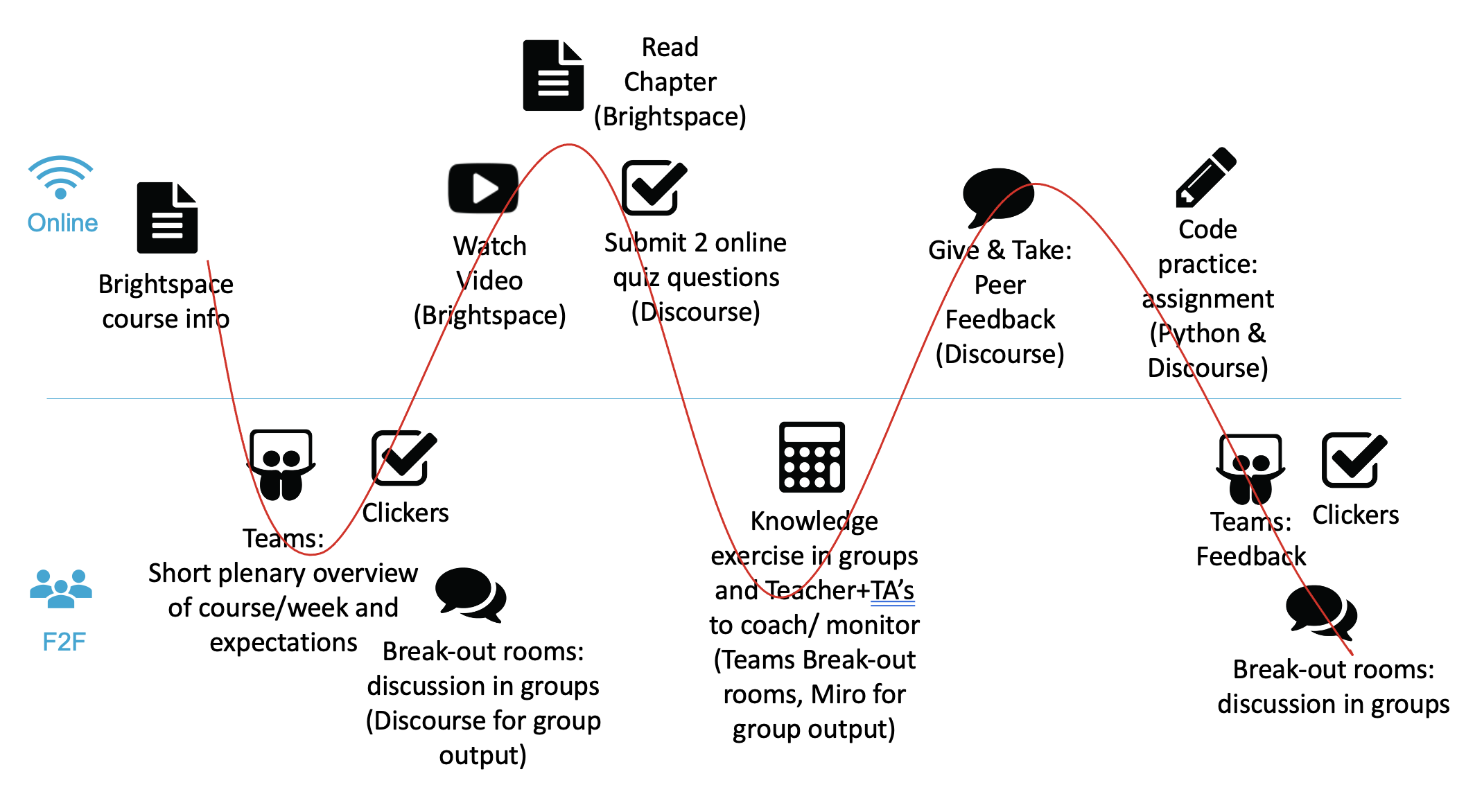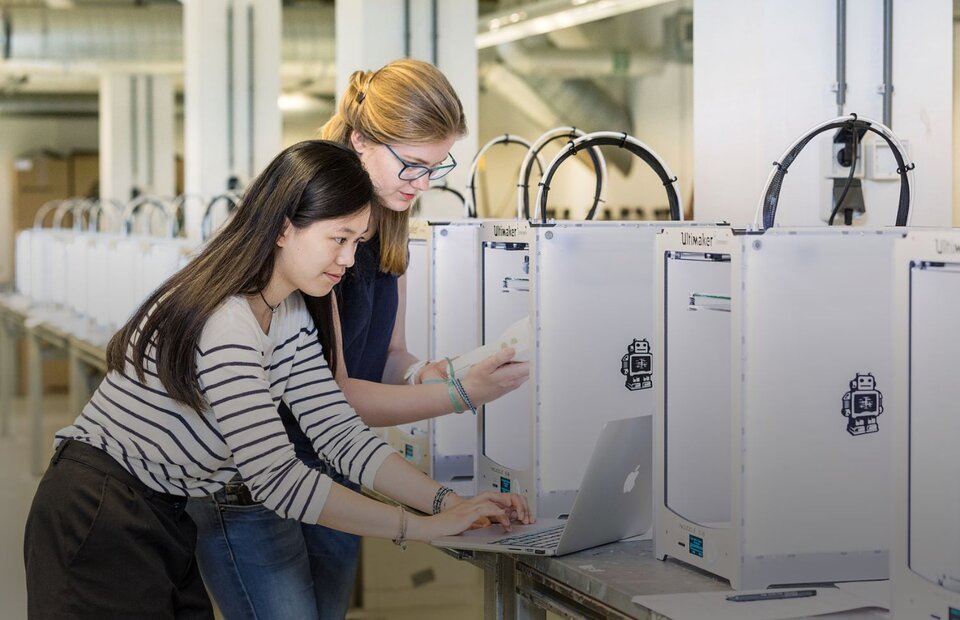IDE TEACHERS' MANUAL
Facilitating Education
-
The process of developing and revising a curriculum usually starts by exploring the needs and developments in the respective professional field. This information is then used to formulate a graduation profile or to revise an existing profile. This graduation profile forms the basis for:
- The degree programme’s final attainment levels, i.e. the competences that students should have acquired by the end of the programme. The final attainment levels of each degree programme are laid down in the Teaching and Examination regulations, OER (BSc) appendix 2 and TER (MSc) appendix 2
- The didactic concept of the degree programme. This is a vision on how students learn and how teaching will be organised. This includes the structure of the programme (number of courses that are offered in parallel and that last a whole quarter or semester, etc.), the modes of instruction and assessment and key preconditions with regard to ‘studyability’ (e.g., spreading deadlines, equal distribution of the study load, etc.).
Once the final attainment levels and the didactic concept have been established, work starts on designing the programme’s courses. Each course is assigned a set of learning objectives that contribute to the realisation of the programme’s final attainment levels.
To verify whether all final attainment levels are adequately covered in the curriculum, an ‘X table’ is used to establish which courses address which attainment levels. This document provides an insight into the learning pathways of a programme (i.e., which courses build on each other). Contact the relevant director of studies to see this ‘X table’.
Therefore, a course does not stand alone; it is vital that there is cohesion between the courses within a curriculum in order to ensure that:
- There is no overlap and/or there are no gaps between the courses;
- Students can apply and integrate the knowledge they have learned in one course in other courses.
This requires good mutual coordination between the courses.
-
What do the students need to learn? How can you assess that? These are the two main questions that you need to ask yourself when developing a new course or revising an existing one. The first key steps in this process:
- Formulate learning objectives within the given set of final attainment levels, taking into account the initial level of students.
- Develop the modes of instruction and assessment to be used within the course, taking into account the didactic concept of the program.
- Ensure there is constructive alignment within the course.
- Make sure that the educational activities fit within the course’s study load.
- Select course material.
Learning Objectives
Precisely formulated learning objectives are key to achieving constructive alignment. Bloom’s taxonomy is a useful tool for this. This taxonomy, which is widely used throughout TU Delft, helps to describe not only the subject but also the proficiency level (what should the student know and be able to do at the end of the course). See also here.
Constructive alignment and formulating learning objectives (using Bloom’s taxonomy) are covered in the DEVELOP UTQ module.
You can find more information about formulating learning objectives here and here.
Constructive Alignment
The crux of this concept is that all of the elements in a course – intended learning outcomes, teaching methods and assessments – should be aligned. Click here for more information.
An example using two learning objectives at different Bloom levels:
If the learning objectives state that students should know the basic principles of a certain topic (Bloom level ‘remembering’), these basic principles can be taught to students through lectures. This knowledge can then be assessed through a question in an exam, in which the students have to explain the basic principles.
If the learning objectives state that students should be able to apply the basic principles of a certain topic (Bloom level ‘applying’), then teaching through lectures alone is no longer enough. Students need to learn to apply that knowledge, for example, by carrying out an assignment. In addition, a knowledge-based question on the exam is not a suitable way to assess whether the student can apply the basic principles; an assignment in which this knowledge is applied is much more appropriate.
Experience shows that students’ study habits are mainly determined by the type of assessment. If knowledge and/or skills are assessed that are not stated in the learning objectives and/or are not covered during the educational activities, then:
- It is difficult to know whether a student has mastered the learning objectives by the end of the course.
- The first opportunity for the student to practice that knowledge and/or skills is during the assessment. Students should learn throughout the course, not during the assessment.
Assessment
The assessment of a course can consist of summative and formative tests. A summative test is a compulsory component of the course and counts towards the student’s final mark. A formative test is not compulsory and is intended to give the students feedback on/information about their progress. A formative test does not count towards the final mark.
Important factors when designing tests:
- Review the rules for marking a course, the pass-and-fail rules for a course, the opportunities to upgrade the mark for a practical exercise with a compensatory assignment, the marking period and the opportunities available to students to inspect their marked work in the Teaching Regulations.
- Ensure the constructive alignment of the course: the type of assessment must match the learning objective and the Bloom level. The Assessment Matrix can help you with this.
- Ensure that it is possible to determine for each individual student that they have achieved the learning objectives.
- Ensure that all learning objectives are addressed in the summative tests.
- Take into account the guideline of max. one summative test per 2.5 ECTC.
- Think about possible formative tests that will help the student prepare for the summative tests.
- Coordinate with the course coordinator to prepare the assessment and involve several lecturers when designing the test(s).
- Prepare the assessment tools, such as an answer model and the rubric.
- Ensure objective marking by several lecturers and in several studios (e.g. training lecturers, assessment tools, benchmarking, etc.)
In accordance with its statutory task, the Board of Examiners regularly evaluates the quality of the tests used in courses in order to provide feedback and to ensure the quality of assessments.
If you have any questions about the assessment of your course, please contact educationregulations-ide@tudelft.nl.
If you want to make changes to the assessment of your course, please submit these for approval to the Board of Education via opleidingsdirectie-io@tudelft.nl.
Teaching methods
Once the learning objectives and assessments for a course have been formulated, you can start selecting the teaching methods/activities and didactic methods. During the development of each curriculum, basic principles are laid down regarding the content of the programme as well as the didactic concept. Ask the relevant director of studies about this.
All curricula at IDE encourage proactive and self-directed learning, based on the theory that students learn by experiencing and reflecting. In other words, learning by actively applying knowledge and skills. Discussions, assignments and projects are just a few examples of active teaching methods.
Obviously, the type of teaching activity depends on the course and the learning objectives of that course. Bloom’s taxonomy offers some examples for this too (see also this overview). A rule of thumb when structuring a course is that the ratio of contact time to time for independent study should be about 1:3.
The Faculty of IDE attaches great importance to the use of forms of blended learning when selecting teaching methods and activities. Click here for more information.
More information about the educational tools used at TU Delft is available here. These tools comply with the General Data Protection Regulation, a complete overview of tools who do or do not comply to this law can be found here.
Study Load
The study load of a course is expressed as ECTS credits (ECTS = European Credit Transfer System). One ECTS equals 28 study hours, i.e. hours that an average student must devote to the course in order to complete it successfully. These study hours include contact hours, online activities, working on assignments and projects (individually or in a group) and hours for independent study. Please keep in mind that the group process also takes time when doing group work.
When planning a course, it is advisable to draw up a detailed study-load plan to check whether it is possible to complete the course within the allocated timeframe. This will help you to run through the activities you have designed for the course and consider how much time an average student will need to complete the activities successfully. You can ask your colleagues to check or ask student teaching assistants to test your estimation for the study load.
For guidelines on reading/studying course material, click here (coming soon!).
Course Material
Course material can be a range of resources:
- A book that students have to buy.
- A reader/lecture notes comprising self-written material, articles and/or parts of books. Readers are often used to help keep the cost of books within reasonable limits for the students.
- Open-source material available on the internet.
You can decide to use both mandatory and recommended course material.
When compiling readers/lecture notes, you must pay particular attention to the publication and reproduction rights (short and non-short extracts). More information about this topic is available here.
Lecture notes can be uploaded to the Microweb.edu online store, so that students can order them (digital or printed copies).
-
Online learning
‘Online learning’ is the term used to describe all teaching that is offered entirely online. It applies to courses offered both within and outside the degree programmes. At our faculty, for example, we offer Massive Open Online Courses (MOOCs) that everyone can participate in as well as fee-based professional online courses.Do you want to develop an online course for target groups other than our BSc and MSc students? Please contact the faculty coordinator for blended and online learning. It is essential that all the courses we offer entirely online are in line with the priorities and portfolio of the faculty and TU Delft. The faculty coordinator can provide more information about this.
The faculty coordinator can also help you create a proposal, arrange registration and funding, put you in touch with student teaching assistants or learning developers and find training opportunities and support, among other things.
Contact: José Hekkens
Blended learning
The faculty has stipulated that all BSc courses must include an element of blended learning. This means that a course comprises a coherent mix (blend) of on-campus and online activities; the considered combination and integration of on-campus and online activities that complement and reinforce each other. Students can generally complete the online activities in blended learning, which are not time-restricted, independently. An example of an effective mix is when information and new knowledge is provided to students in a video and then further deepened and discussed during the contact moment using a realistic case.An effective mix of activities results in a better learning experience for students. Technology can play a supporting role here (e.g., Brightspace, MS Teams, videos, podcasts).
The fact that all courses in the new Bachelor’s curriculum are required to apply blended learning does not mean that there is a one-size-fits-all solution. Each course will require its own blend, tailored to the learning objectives, course content, lecturer and phase in the curriculum. This variety also makes the range of courses offered more challenging for students.
The Learning Wave visualizes the unique blend of on-campus and online teaching within a course. See below for an example: the Learning Wave of the course IO1075 Software Based Products (2021/21 Q3) / IOB2-2 Digital Product Development (2021/22 Q2). The icons illustrate the variation between synchronous and asynchronous activities during a week. The red line indicates the importance of the link (interconnectivity) between synchronous and asynchronous activities.

Blended Learning team & Studio
The IDE Blended Learning team provides support to course coordinators and lecturers in the design and teaching of courses. The emphasis here is on the blended component. The team, which consists of an advisor and student assistants, provides advice and practical support for the following activities:- Selecting, testing and applying various online tools based on the needs of the lecturer (e.g. for sharing group work online, activating students online using a discussion forum, selecting a formative assessment tool or online communication tool)
- Advising on and producing videos and podcasts in various formats (including editing and graphic design)
- Optimising the course’s section on Brightspace
- Broadcasting lectures live
At the end of 2021, the faculty launched a new facility for lecturers: the IDE Blended Studio. This studio is managed by the Blended Learning team and can be booked by lecturers to record videos and to broadcast lectures live. The student assistants provide support by advising on different settings and offer technical support during the recording and editing process.
To book the studio, send an email to Nancy de Groot.
On the Bringing Design Education Online page on Brightspace, you will find more information about the Blended Learning team, the Blended Studio, examples of blended materials used in other IDE courses and useful tips and manuals.
Contact: Blended-Studio-IDE@tudelft.nl
Useful links
- Click here for an overview of all the tools used at and therefore supported by TU Delft.
-
If you are designing a new course, or redesigning an existing course, you might want to contact the Education Advisory team.
-
IDE Course Support (IDE CS) helps BSc course coordinators with the organisation and administration of their course(s).
IDE CS invites course coordinators for an intake interview about a month before the start of their course. A checklist is used to make agreements about the activities.
IDE CS is on hand to help set up Brightspace, draw up lists of participants and create groups, register results (in Brightspace and/or Osiris), organise facilities, use Collegerama and register illness notifications (for more information on illness notifications, see the information on this topic in the BSc course manual format).
Limited support is also offered for MSc courses. Please contact the IDE CS staff for more information.
Contacts at IDE CS:
- Manon Borgstijn: M.M.borgstijn@tudelft.nl
- Jolanda van Domburg: J.J.A.P.M.vandomburg@tudelft.nl

-
The courses offered as part of the Bachelor’s degree programme and the compulsory courses of the Master’s degree programmes are determined by the Board of Education.
However, staff members are welcome to propose their own ideas for MSc electives.
Do you have an idea for a new MSc elective? Then follow these steps:
- Consult one of the Msc programme directors to check whether the subject of the new elective would be a good addition to the range of electives on offer.
If the reactions are positive, please contact the ESA department (via coe-io@tudelft.nl) to request the ‘Application form for a new MSc elective’. You should complete this form and submit it to the Board of Education; it will then be put on the meeting agenda for approval. Send the completed form to opleidingsdirectie-io@tudelft.nl.
Note: proposals for new electives should be submitted by the end of January at the latest in order to be included in the range of courses offered in the next academic year.





